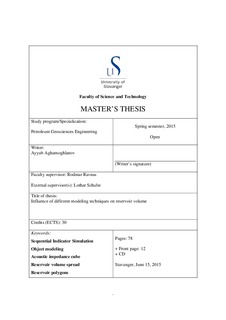Influence of different modeling techniques on reservoir volume
Master thesis
Permanent lenke
http://hdl.handle.net/11250/300392Utgivelsesdato
2015-06-15Metadata
Vis full innførselSamlinger
Sammendrag
Facies modeling is one of the initial stages on the way to reservoir volume calculations. Typically, for each depositional environment a particular facies modeling method is used. The geology of the area of investigation can be described, by a stacked channel (deltaic) depositional environment. This work represents a set of models, which are created using Object Modeling and Sequential Indicator Simulation method. Each facies modeling method has its own parameters, which are influencing the reservoir volume. Sequential Indicator Simulation is a pixel based modeling method, which is based on an estimation of the probability of each facies at every grid point. The facies at the grid point is derived from the cumulative distribution function (CDF) of the facies probabilities and a random number generator used for deriving the facies from the (CDF). The main modeling parameters of the Sequential Indicator Simulation method are: The Global seed number, which is controlling the random number generator, the Major, Minor and Vertical variogram range. In the Object based modeling method, the main parameters describing channel geometry are: Thickness, Width, Amplitude and Wavelength.
One of the main purposes of this project is to investigate the influence of the modeling parameters on the reservoir volume spread. Research is also covering the influence of the well positions with respect to the upscaled well, on the reservoir volume spread. This is accomplished thru defining areas of investigations at different locations with respect to the one upscaled well.
Another topic of the thesis is the study of the influence of the “Global facies fraction” on the reservoir volume.
Finally, a close look is taken on the seismic impedance as a guide for facies modeling, which can help reducing the reservoir volume uncertainty. The outcome of the study will be a set of recommendations for facies modeling of a stacked channel environment that result in a more reliable reservoir volume estimation and uncertainty evaluation.
Beskrivelse
Master's thesis in Petroleum geosciences engineering
